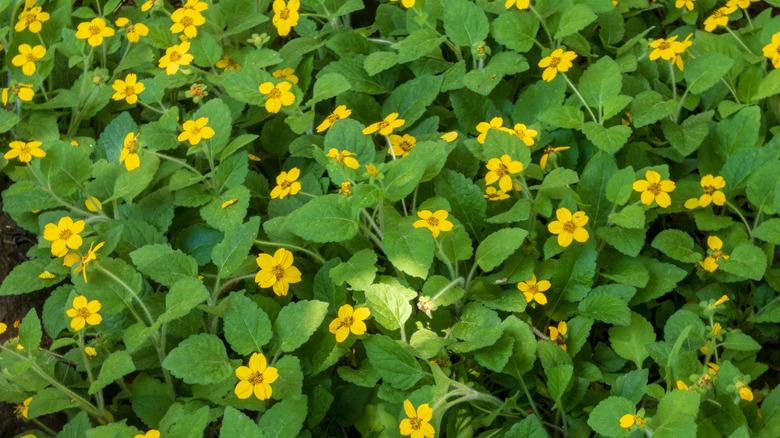The Ground Cover That Makes A Beautiful Alternative To Grass Around Trees
Grass may be the most common choice for ground cover, but that doesn't necessarily mean that it is the best. Especially when dealing with persnickety areas like the shaded and rooted areas around trees. If you haven't had much luck with grass or simply want to explore your options, one great grass lawn alternative is Chrysogonum virginianum, which is also known as Green-and-gold. This plant is distinguishable by having a majority of green leaves with yellow, daisy-like flowers interspersed throughout. Because it does well in partly shaded areas, it is particularly suited to covered areas, and it tends to spread quickly, especially when left alone.
To get some real insight, Hunker spoke to Master Gardener Jennifer Martin exclusively to see exactly why this plant could be the answer to your tree-shrouded, full-lawned prayers. "For one thing, Green-and-gold is native to North America and more beneficial for pollinators," said Martin. While she mentioned that the flowers are only present in the warmer months, she added that "It's also semi-evergreen, which could mean color year-round for some people." One concern with grass alternatives is that they won't hold up as well as the OG. But Martin said, "Unlike some other ground covers, it can handle foot traffic pretty well."
Where to plant and where not to plant
Though many people attempt to grow grass where tree roots are, it can be a tricky task to master. Some types of grasses do not thrive in the shallow soil and shade, and competing for nutrients with the tree can leave it looking brown with envy and malnutrition. But Green-and-gold is a bit better at holding its own. If you have a yard that is on the shadier side, you may be able to use it in place of grass across your entire yard instead of just around your trees. Martin told Hunker exclusively that Green-and-gold also thrives in moist, acidic soil. "They can grow from zones 5 to 9, so you can try them in any of those zones," said Martin. Those zones include a majority of the U.S., save for some of the more northern states. Though you can try to plant Green-and-gold outside of these zones, chances are that it will not have as lucrative a growth, and it may not fare as well or as long as it would in a warmer climate.
When it comes time to actually put your Green-and-gold in the ground, most people should find that it grows pretty easily. Martin did note, however, that the key to getting it to grow well is location. "It's pretty easy to grow, but you really need to plant it in the right kind of spot from the get-go: fertile, acidic soil that's not too dry, with each plug about a foot apart. They'll fill in quickly. And keep the soil around a Green-and-gold moist, especially when the plants are young."
What to expect with maintenance and tips to keep it looking great
If you are seriously considering Green-and-gold as an option, you will want to make sure that you are prepared and willing to care for it properly so that you can get it looking its best. Overall, Martin told Hunker in an exclusive interview that it is generally much easier to care for Green-and-gold than it is to care for grass. "If you are growing it in full sun, you'll need to provide consistent, well-draining moisture. Its preference is dappled sun to part shade, though it can even handle deep shade." Martin also noted one of the biggest benefits, however, which is that it never requires mowing.
There is one somewhat annoying maintenance task that Martin mentioned, which she said is necessary if you want to keep them looking full and healthy. "It's a miserable task, but digging up and dividing the plants occasionally will increase airflow, and deadheading the spent yellow flowers will help it stay healthy and give you better and more blooms."


